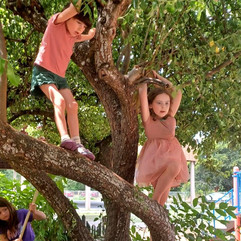Summer Camp III
- Serene
- Aug 20, 2024
- 2 min read

Inspired by Cezanne
Paul Cézanne, the 19th-century painter from Provence, is often called the "Father of modern art." This title reflects the profound influence he had on the development of 20th-century art movements, from Cubism to Expressionism. Cézanne's work was also deeply rooted in the past, drawing inspiration from the timeless beauty of nature. His unique blend of traditional techniques and revolutionary ideas made him a pivotal figure in the history of art.
Cézanne was born and raised in Aix-en-Provence, a region in southern France renowned for its lush landscapes and vibrant colors. The natural beauty of his homeland had a profound impact on his art, and he returned to the subjects of mountains, trees, and fruit again and again throughout his career. His paintings of the Mont Sainte-Victoire Mountain, for example, capture the rugged majesty of the landscape, while his Still Lifes of apples and peaches render fruit with a solidity and weight that borders on the monumental.
Cézanne's love of nature was not just visual; it was also deeply philosophical. He believed that the natural world held the key to understanding the underlying structure of art. He famously said, "Art is a harmony parallel to nature," suggesting that the rhythms and forms of the natural world could provide a model for creating balance and harmony in painting. Cézanne's influence on modern art is immeasurable. His experiments with color, form, and perspective paved the way for a generation of avant-garde artists. Pablo Picasso and Georges Braque, the founders of Cubism, were particularly inspired by Cézanne's fragmented forms and multiple viewpoints. Today, Cézanne's paintings continue to inspire artists and remain a touchstone for anyone interested in the intersection of tradition and innovation, representation and abstraction, and the timeless beauty of the natural world.
_____________________________________________________________
This summer was so much fun in our new space. Last week was no exception. We explored the work of Cezanne, and the class was full of inspiration as we did Sculptures, chalk pastel Still Lifes, Mixed Media Collages and Landscape Paintings. The balmy weather was perfect as we enjoyed nature walks to Abernethy to have lunch in the garden. On Weds. Lisa Wilkes the "Tree Lady" gave us a talk about all types of trees, followed by a papermaking lesson.


















































Comentarios